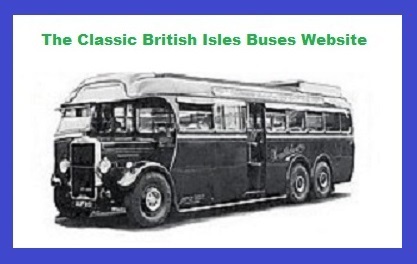

The Classic British Isles Buses Website
Transport in Argentina, page 2, the search for Di Tella 2011 (by Dick Gilbert)
Last updated 26 August 2024
Email Events diary Past events list Classified adverts Classic U.K. Buses Classic Irish Buses Classic Manx Buses
| Buenos Aires buses in 2011 | Di Tella cars in 2011 | Aircraft in 2011 | Railways in 2011 and 2018 | Classic cars in 2011 and 2018 | Railways in 2019 |
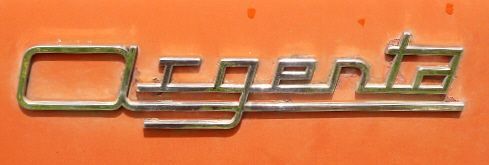
The badge of the SIAM Di Tella Argenta pickup truck, a relative of the Morris Oxford and Austin Cambridge.
These pages review some of the transport items of interest that caught my eye during a fascinating trip to Argentina and Peru in February and March of 2011, and again in March 2018.
This tale came about because my good colleague Shane Conway of the Classic Irish Buses Website learned that I was travelling to Argentina, and was curious about a long-extinct British classic car family that went to South America, and might just still survive there. As a great fan of the Farina-styled Austin Cambridge/Morris Oxford (see his webpages here), Shane had discovered that BMC had granted a licence in 1960 to a company in Argentina to manufacture the car (and its variants) there. That company was SIAM (Seccion Industrial Amasadoras Mecanicas), and the range of cars was named Di Tella after the company's founder in 1911, Torcuata di Tella.
So did any Di Tellas still survive in Argentina? That's the challenge Shane set me, and the story on this page is what I discovered.
My eldest daughter raises polo ponies on a farm just outside a small town named 25 de Mayo (25th of May), some three hours drive south of Buenos Aires on the flat Argentine pampas that stretches for hundreds of miles down the eastern side of the country. This is semi-rural Argentina, and the modes of transport bear no resemblance to what you would find in the modern capital city. If I was going to find a Di Tella, it would surely be here, if anywhere. So I decided to spend some time hunting Di Tellas around the town, with the assistance of my daughter's partner, his father, and her monster bright yellow 3-ton, 6-wheel, 7.3-litre, much-modified Ford F350 pickup. I was taken to visit Mr Cesar Didonato, a local teacher. How was he going to help us?.

Cesar Didonato with his pot of mate tea.
Nothing happens very fast in rural Argentina. First of all there is a lot of hand-shaking and back- slapping, then there is general chat about old times and mutual acquaintances. The next stage is probably to share a pot of the inevitable Argentine mate tea, which takes simply ages, and tastes revolting. Since all this is done in Spanish and I don't speak a word of it, you can see how I might begin to wonder why we made the visit in the first place.
But eventually Cesar rose rose to his feet and led me to a dusty garage, in which was a car I didn't recognise at all, and certainly not a Di Tella. It turned out to be his pride and joy - a dark green IKA Torino.
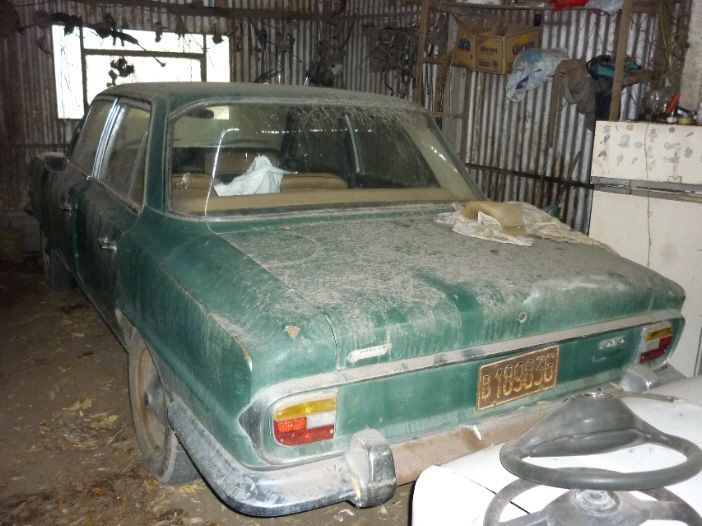
This muscle-car of its time was built in Argentina from 1966 under an agreement with American Motors. IKA was taken over by Renault in the mid 1970s and the car became known as the Renault Torino. His example dated from 1977 and had previously belonged to his father, so he claimed it had 170,000 kms on the clock and only one family owner.
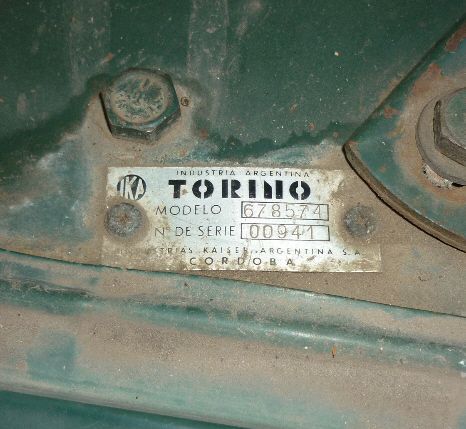
Most Torinos had a 3.7 litre engine, and the same basic design remained in production for fifteen years, with over 100,000 being built. Pininfarina designed the body, and the vehicle was much loved, being sometimes referred to as Argentina's national car.
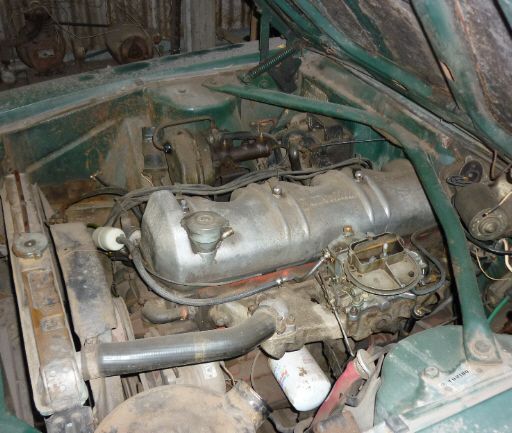
Not only did it have a national identity, but it also had a reputation on the international racing and endurance circuits, where they regularly placed highly in competitions during the 60s and 70s. With the best ones claiming 215 horse power and a maximum speed of 127 mph, they became renowned as powerful machines.
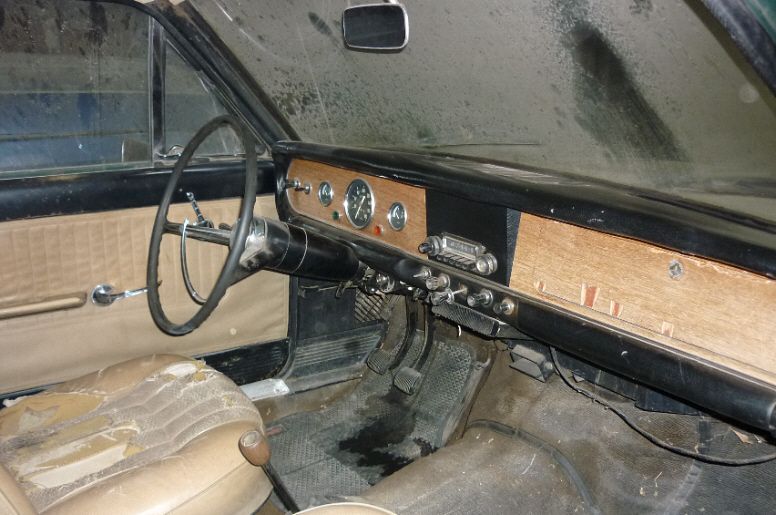
The appeal of the Torino spilled over into the luxury saloon market too, and celebrity owners included Fidel Castro and Colonel Ghadaffi! Anyway, I had never seen one before, and Cesar clearly wanted to impress me with this glorious possession, so I showed suitable admiration. Incidentally, one way Argentineans can demonstrate the power of a car is to show how much noise it makes. If the exhaust has holes in it (or is missing), then the noise is even more impressive, so ragged exhausts are considered an asset. This was demonstrated not only by revving up the Torino, but also similarly with a 2.3 litre Taunus GT parked nearby.
At this point I ventured to mention the SIAM Di Tella, which seemed to have slipped from everyones' minds. Cesar then explained why I was there. His father had been the Di Tella agent in 25 de Mayo, and most of the Di Tellas in town had been sold by their family, so he knew where they were. Unfortunately the news was not good. The last one of their examples had come to grief a couple of years ago, when a political protest in the town had decided to use the last Di Tella as a bonfire to enhance the event.
Cesar pointed to an engine block in the long grass and said that this had come from one. A rusty propshaft T-boned with a rear axle stuffed into a hedge was also from a Di Tella, but that was it - sorry! It looked as though my search was over. But then he remembered something, and we all bundled into the mighty yellow Ford pickup and roared off to a house across town, and there, in the yard behind the house, was a real SIAM Di Tella.
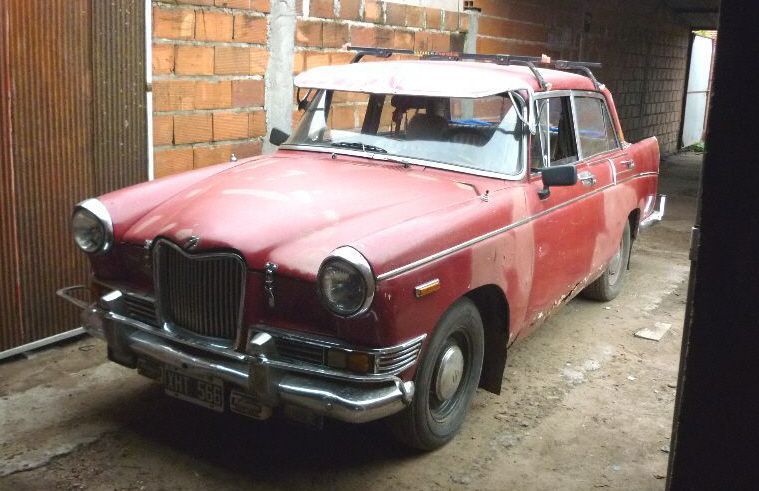
Now it's worth pointing out at this stage how the Di Tella evolved. In 1960 the first model was essentially an Austin A55 Cambridge mk. 2 with a Riley 4/68 grille, built under licence using components from UK. Soon they were being assembled with locally-built parts. All had a 1489cc engine, a 3-speed column-change, and the Riley-styled grille (Argentineans normally pronounce it something like Relay). There were three versions - the saloon Di Tella 1500 (with a taxi variant), the estate (rural Traveller), and the pickup (Argenta) which never appeared in the U. K. In 1964 a fourth model appeared with a 1622cc engine and an MG grille and badge - the Magnette.
In 1964 the whole deal was passed over to IKA (see the Torino item above) who reworked the range. The 1500 sedan remained, but they also offered a Morris Oxford-style grille (actually Shane tells me it had an Australian Austin Freeway front end) to the sedan and estate (both with a 1650cc engine). But IKA was not really interested in the British design, and they all soon went out of production, after something approaching 100,000 of all models had been made.
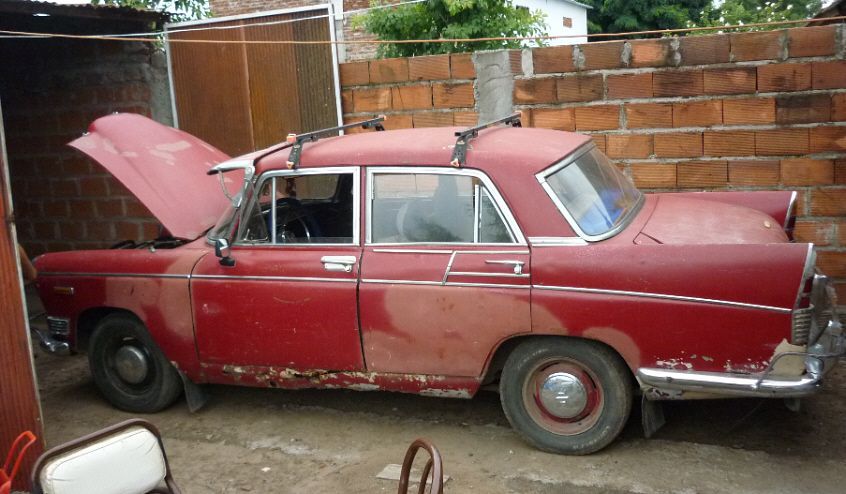
U. K. A50/A55/A60/Oxford/Cambridge owners might consider this example to be a big bundle of problems, but in Argentina it's considered pretty good, and is worth a lot of money. The current owner was clearly very proud of it, and was happy to push it out of his garage and show me around.
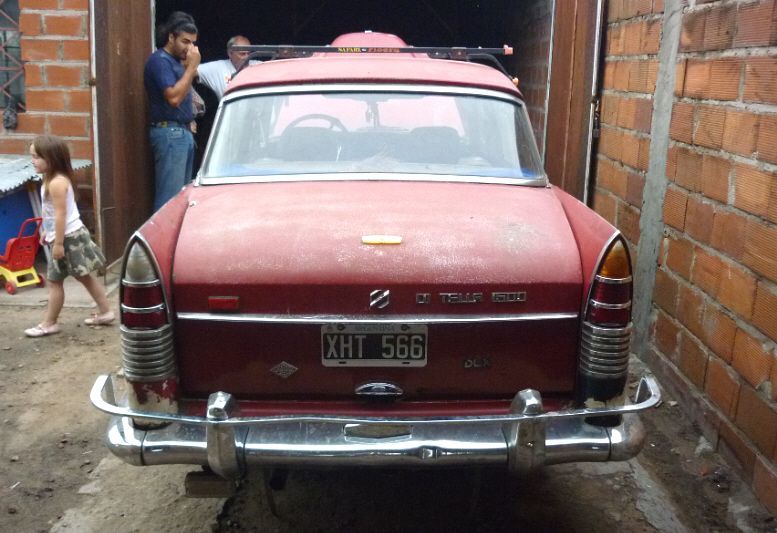

Naturally a part of this presentation required him to fire up the engine and demonstrate the holes in his exhaust. Yup - sounds chunky. On the back you can see the S SIAM logo above the registration plate, and the diamond Riley badge on the left. This, as you can see, is a basic Di Tella Riley 1500 saloon. I was delighted - the Di Tella lives.
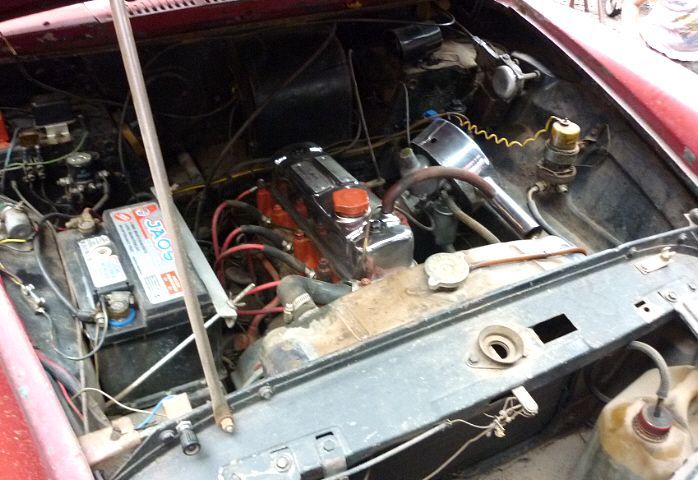
The engine compartment should be pretty familiar to U. K. owners of the BMC range of similar saloons. Surprisingly the owner told me that it's still possible to get parts for these cars, and their popularity as taxis in Argentina for many years may account for that, but when he proudly showed me a faded cardboard box containing an unused brake cylinder, and made a big issue of it, I began to wonder if spare parts were quite as common as he would have me believe.
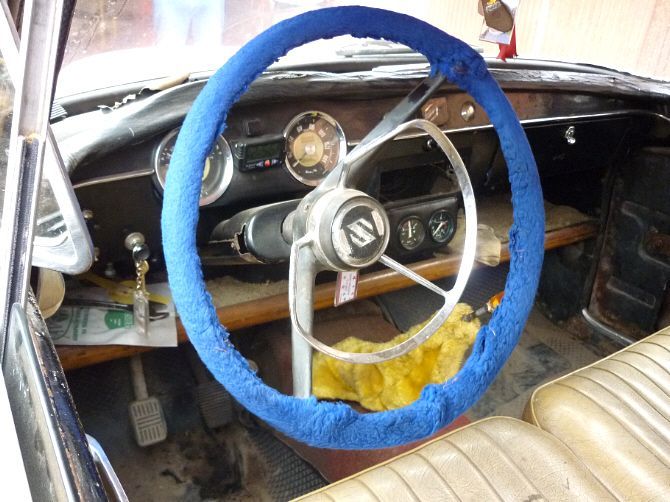
Clearly the owner liked plenty of fur! Note also the SIAM logo in the centre of the steering wheel, and the fact that this particular model had a stick shift rather than the more common column gear change. Anyway we eventually said our farewells, after the owner said that there was another Di Tella for sale at a shop down the road. So off we all went once more in the mighty Ford banana boat.
There were a few false alarms, when we thought we had spotted a Di Tella by the roadside but it turned out to be a Peugeot 404 (they do look very similar from a distance), but then we saw something that looked like the real thing.
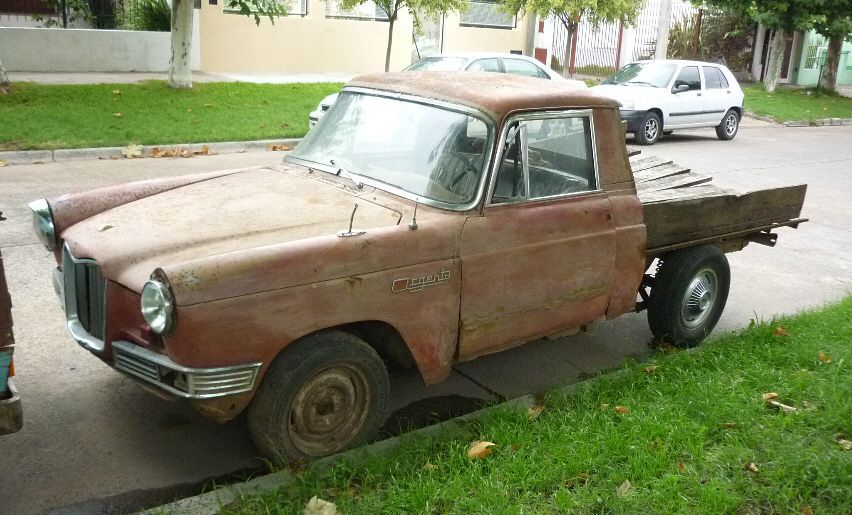
Here was an example of the Argenta pickup, again with a Riley grille. Sometimes old taxis were chopped up into pickups, but this was genuine - it even had the badge on the side. It had clearly seen life, but then most Argentas had an agricultural career, so a little wear and tear was hardly surprising.
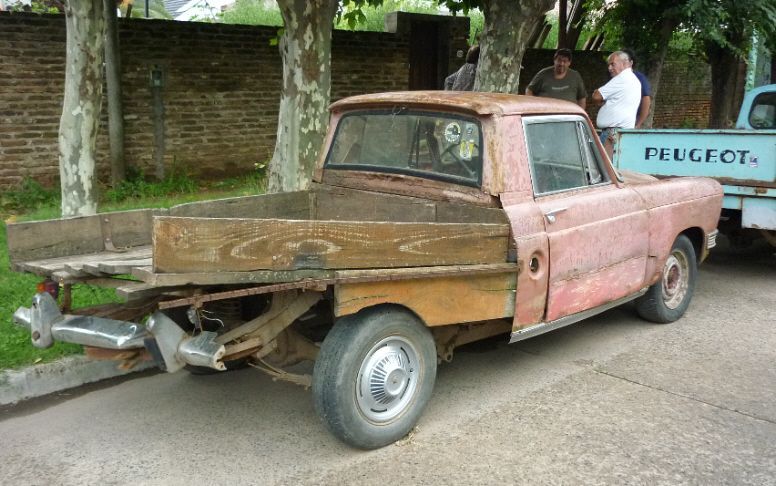
A walk round the back revealed a little more wear and tear. The owner soon turned up (in the grey t-shirt to the right of the tree) and explained that someone had run into the back of the vehicle and virtually destroyed the rear spring (as you can see), but it still drove OK, so he was going to keep it working like that for now.
Eventually we pressed on to the shop where we had expected to find a Di Tella for sale, but - bad news - it had already been sold. Good news - they knew who had bought it. So we set off again and soon found the car with its new owner. It was another Argenta pickup, and this time in better condition.
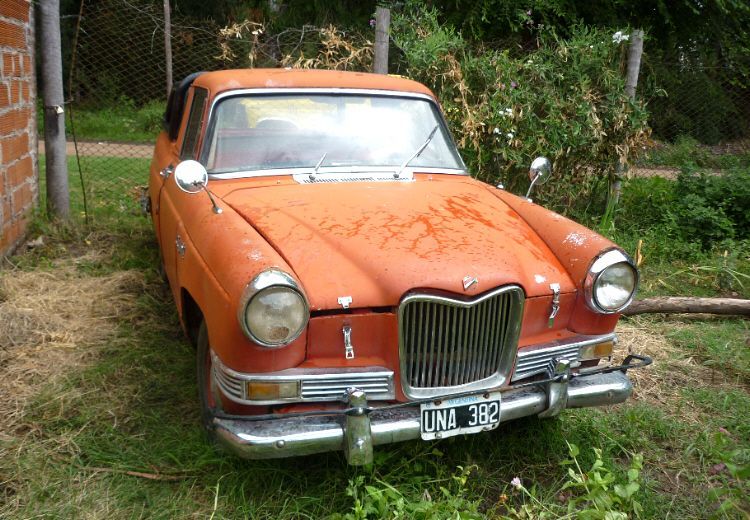
The bars across the top of the bumper (front and rear) seem to be a standard fitting, in a bold attempt to prevent the hazards of Argentine driving wrecking the chromework (or worse). Below we see the basic lines of the Argenta. I don't think the extra bars on the back are original, but the hubcaps with SIAM logos definitely are.
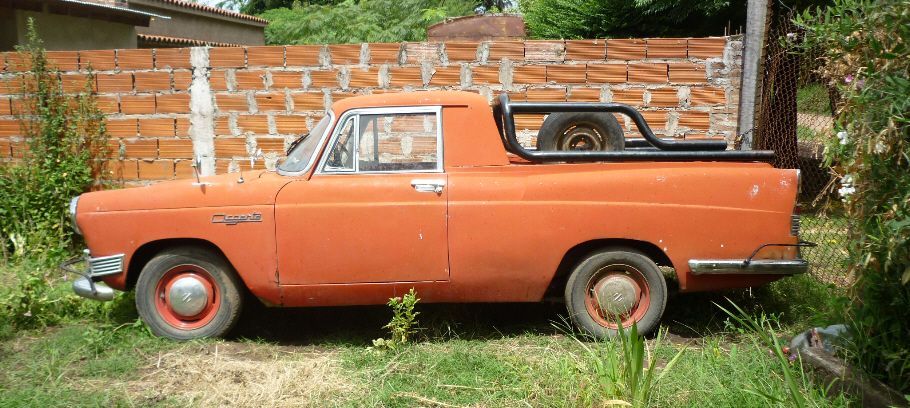
The engine compartment below all looks very familiar to me, and surely to many Brit classic car fans too. It may be only a 4-cylinder 1500cc engine, but it can apparently haul half a ton in the back of an Argenta. On the pampas that probably means a lot of bales of straw, or perhaps 2-3 beef heifers.
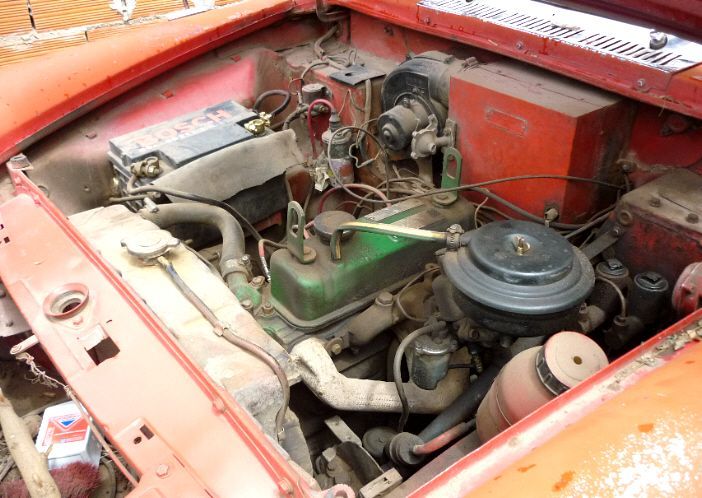
Inside we have a similar view to the saloon model above, but this time there is a more traditional column change 3-speed gear lever.
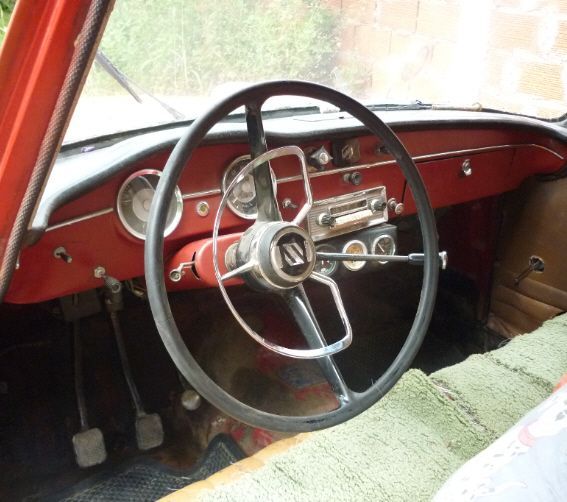
Another interesting feature is the radio. It doesn't show clearly in the view below, but the two white push buttons between the volume and tuning knobs are labelled MUSIC and SPEACH.
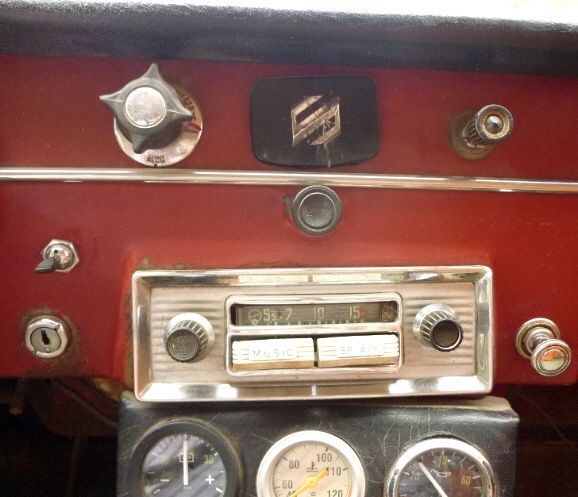
I presume these are tone control options, but why SPEACH? If it was an English radio then it would be spelled correctly. If it was an Argentine radio then the labels would presumably be in Spanish. I don't get it. Having spent a long time chatting to the proud owner about his new acquisition, we finally set off home. But, just down the road, we found another one!
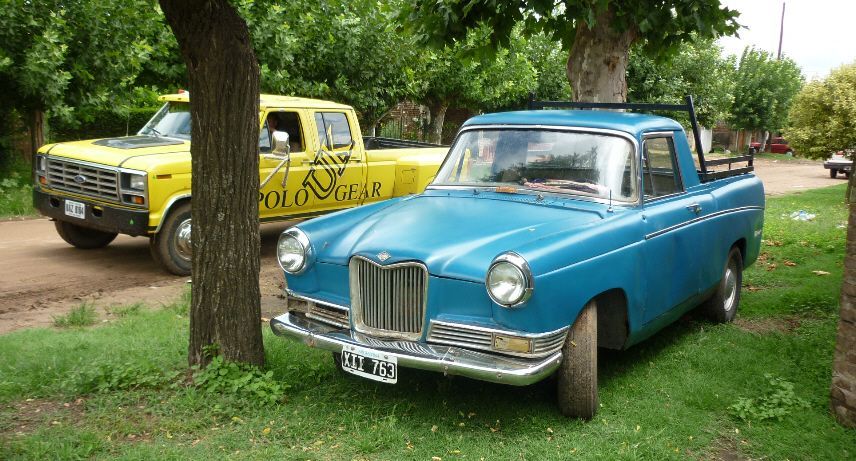
This was the smartest Di Tella we had seen all day, and was the first we had seen with a Riley badge over the radiator grille, rather than a SIAM logo. By the way, that's my daughter's mighty Ford F350 big banana boat in the background. 7.3 litres of pure chugalug. A real head-turner round the town, I can tell you.
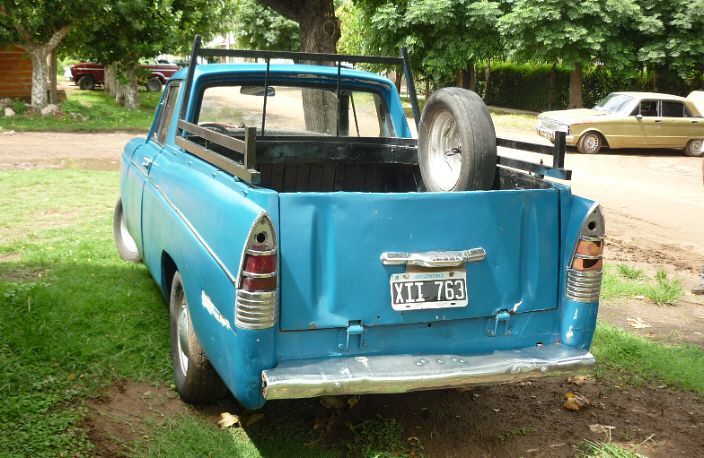
Apart from the broken lenses and a few scrapes and missing bits, this is the Di Tella Argenta as God intended it. So that was the end of the search. We took Cesar back to his place, but the next day he asked us back, and presented me with an Argenta owners handbook, and all the Di Tella technical circulars that the factory had sent to their service agents, starting with no.1 from April 1960 to no. 114 of August 1965. Thanks very much, Cesar.
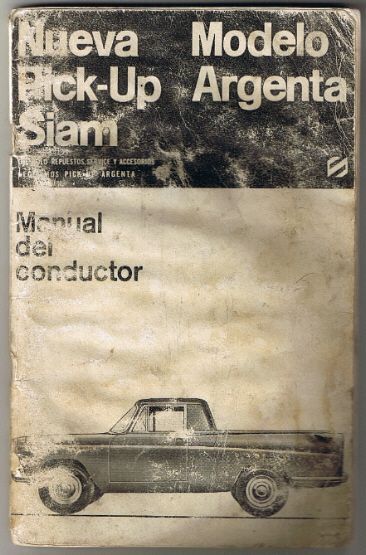
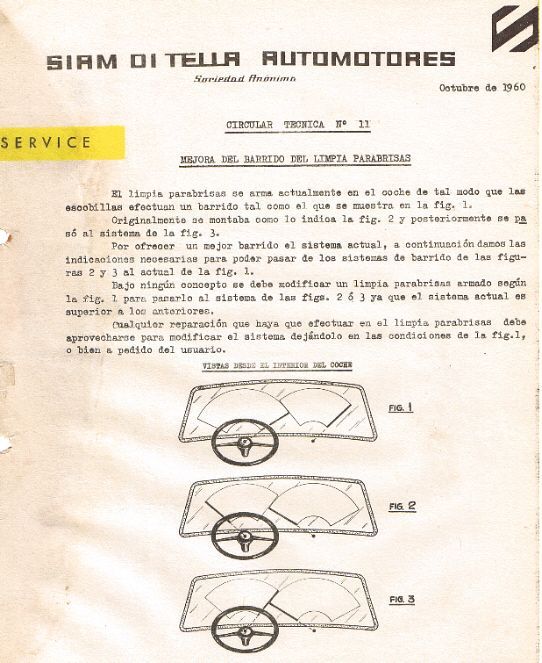
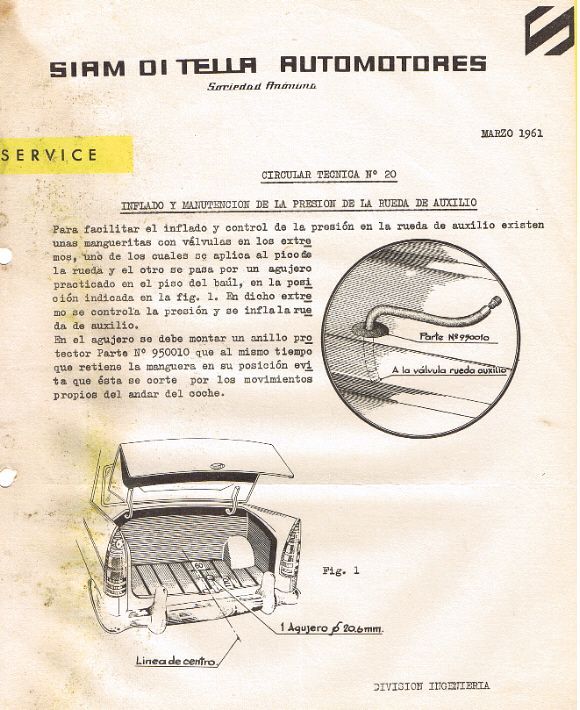
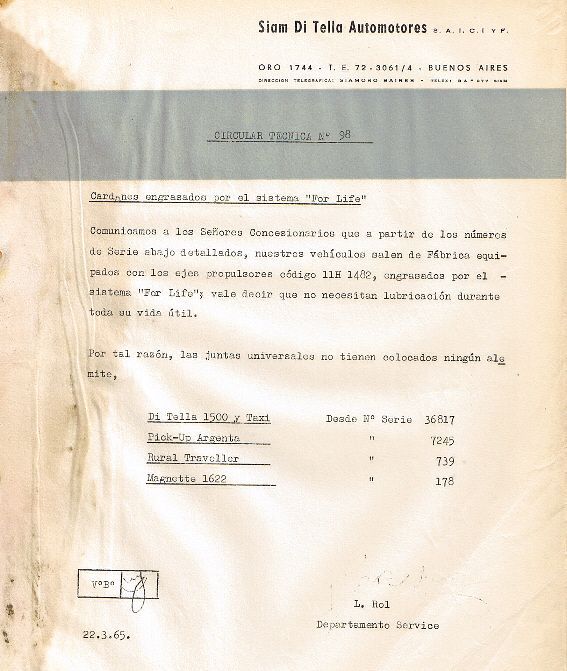
Well that's basically the end of my Di Tella story. Many thanks to all the folks in 25 de Mayo who helped me put this together, and especially to Cesar, who turned out to be essential to the research. I guess that you could get similar results from towns all over Argentina, so there's no doubt that the SIAM Di Tella is alive and well in 2011.
A Postcript: Nicholas Pusenjak from Australia sent me the following in December 2011:
"I visited South America with a group of railway enthusiasts in 1975 and have no recollection whatsoever of seeing the Di Tella cars. The main aim of the trip was to see the remaining steam trains and most of our time was spent away from large cities and in the back blocks. I had one free day in Buenos Aires and have gone through my slides to see what classic cars lurk in the street scenes."
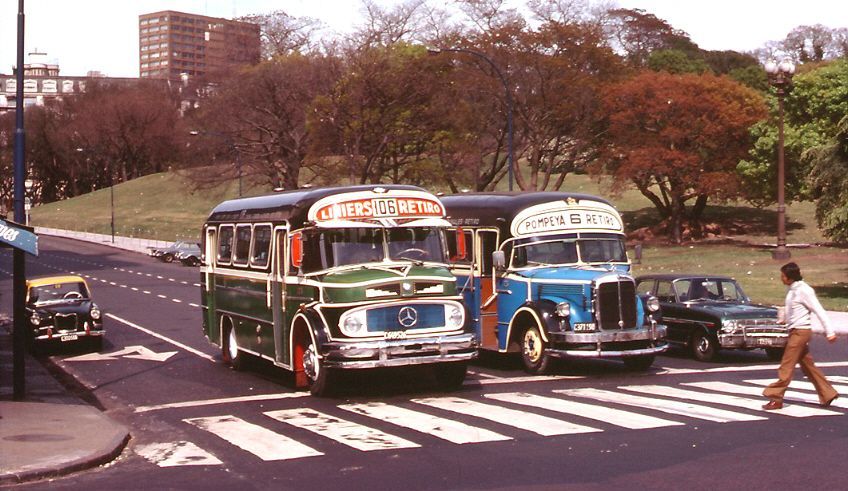
"And lo, in the corner of one shot is a Di Tella - probably a taxi and it appears to be in good condition. The cars I was fascinated with were their Ford Falcons. The Ford Falcon was until comparatively recently a huge seller here in Australia. In 1967, the model received a new larger body that ran into four versions, before being replaced with a square Ford Granada-looking one. But in Argentina in 1975, new Ford Falcons were still using derivatives of the 1960-shape body."
"I am surprised I didn't take more notice of the Di Tella, as I am into classic cars as well and have owned a 1948 Jaguar since 1973. But 36 years ago I was but a callow youth!"
Postscript; Sadly Nick Pusenjak passed away suddenly in May 2017. He had been sending me photos and comments from Australia for years and was an amazing source of information about Australian buses and other old transport matters. His contributions can be found all over this website, and will remain there for ever as my tribute to a fine fellow who is sadly missed.
Another Postscript: In November 2013 my daughter and her partner Diego in 25 de Mayo (yes, she's
still there, and the big Ford banana boat is fine - thanks for asking) informed me that a Di Tella Magnette was being advertised
in the local paper. Two pictures were sent, and here's the first one:
This suggests that the car is in pretty reasonable condition - at least the chromework looks okay.
Note the MG Magnette grille with an octagonal SIAM badge. And this is an interior picture. It makes an interesting comparison with the interior of the standard
Di Tella further up the page. Apparently the guy was looking for 10,000 Pesos for the car, which is about £1,000. Would you pay
that for this car in the U. K.? I bet some people would. Prices for any car in Argentina are higher than you might expect, but that
sounds pretty fair to me. Of course, they're trying to sell it as a car, whereas here it would be an interesting oddball.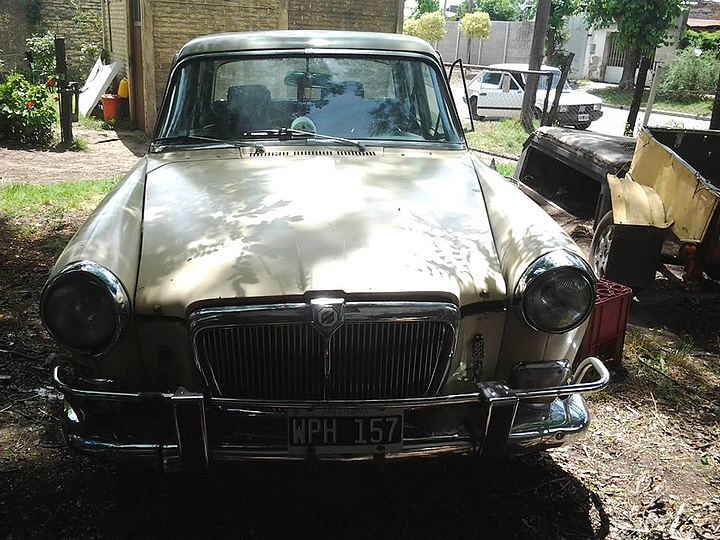
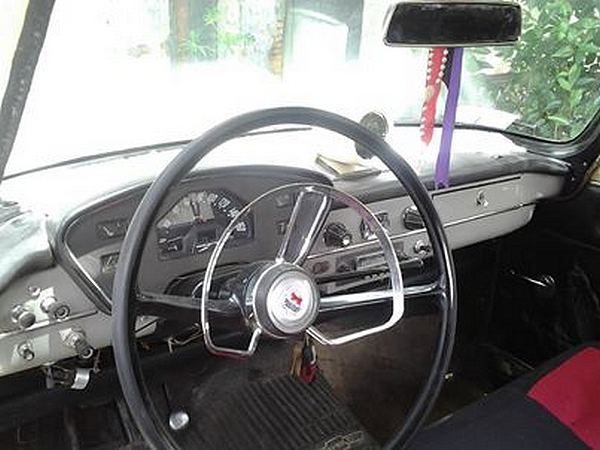
Another Postscript: In March 2018 I returned to Argentina and did some more sniffing around for interesting transport items. In the course of exploring an abandoned railway station just south of 25 de Mayo I found, sitting on the station platform, my first sighting of a Di Tella Argenta pickup from the very first series, probably dating from around 1961.
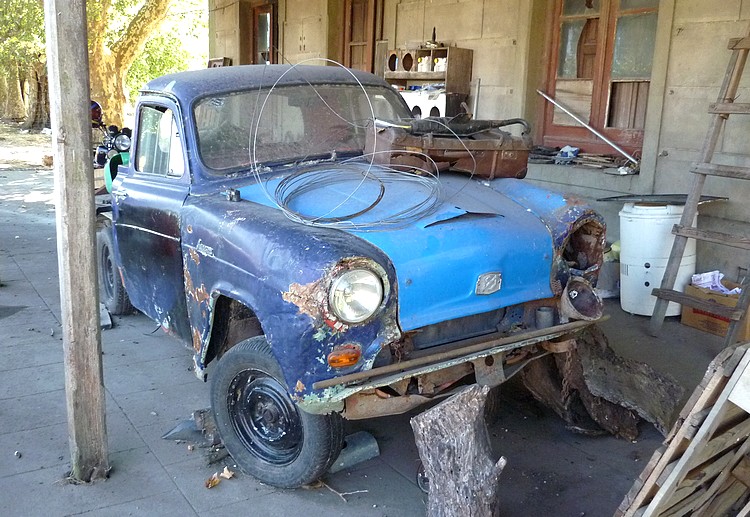
It was derived from the 1950s Austin A50 Cambridge, and this design was only made by SIAM for a couple of years. The shape is instantly recogniseable to older British viewers and surprisingly the SIAM bonnet badge is still in place.
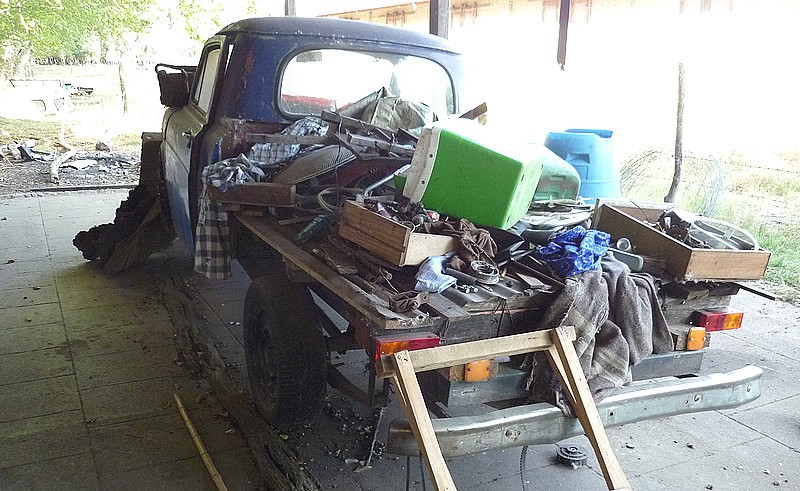
From the back it's clear that many parts have been replaced, and I'm sure that the truck floor, rear bumper and rear lights are not original. But the cab is fairly complete and all the glazing is intact.
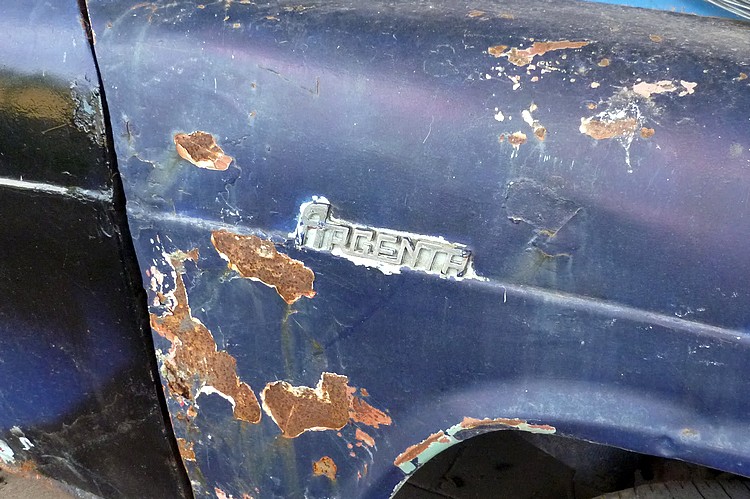
Just to prove that it really is an Argenta, here is the badge on the wing. It's not in the same style as the later version (see the top of this page) and the A reminds me of the design used by Austin back in England at the time.
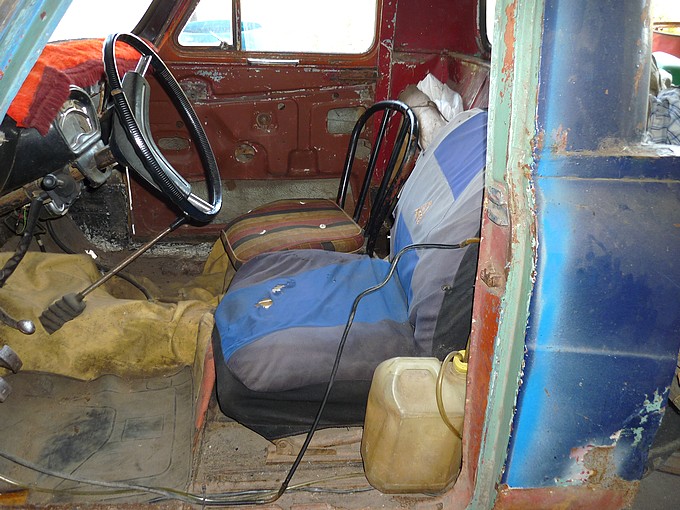
The cab provides some interesting details, especially the passenger seat! Note also that it has a floor-change gear lever (not column change) and there is no SIAM badge on the steering wheel. Clearly the tank sprung a leak (perhaps around the time that the whole back end was replaced) and an alternative fuel supply system has been installed. Try not to trip over the petrol pipe as you climb into the cab!
Email Events diary Past events list Classified adverts Classic U.K. Buses Classic Irish Buses Classic Manx Buses